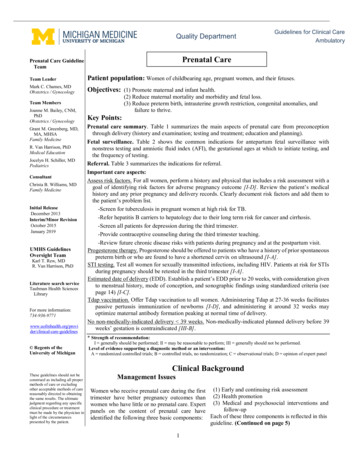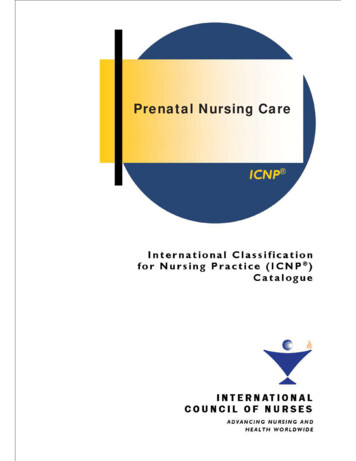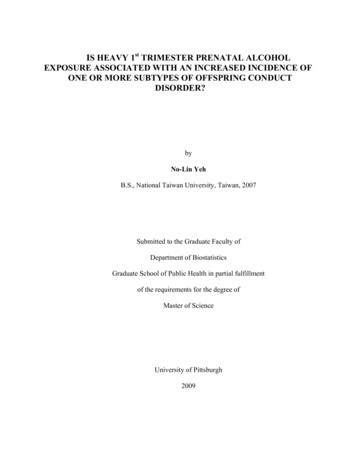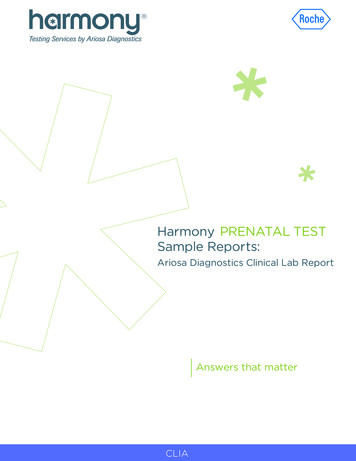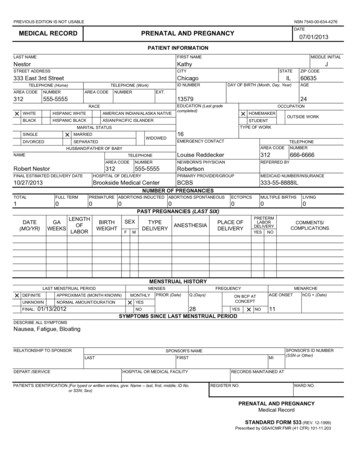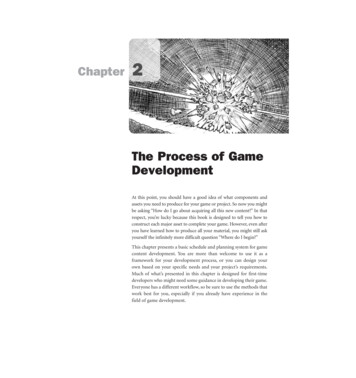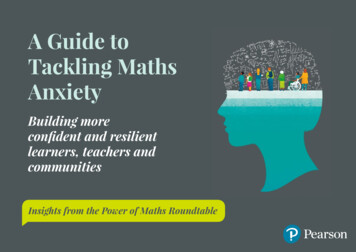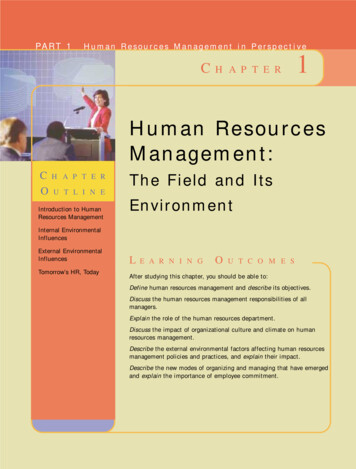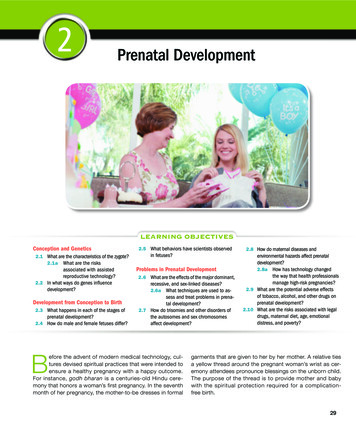
Transcription
2Prenatal DevelopmentLearning ObjectivesConception and Genetics2.1 What are the characteristics of the zygote?2.1a W hat are the risksassociated with assistedreproductive technology?2.2 In what ways do genes influencedevelopment?Development from Conception to Birth2.3 What happens in each of the stages ofprenatal development?2.4 How do male and female fetuses differ?B2.5 What behaviors have scientists observedin fetuses?Problems in Prenatal Development2.6 What are the effects of the major dominant,recessive, and sex-linked diseases?2.6a What techniques are used to assess and treat problems in prenatal development?2.7 How do trisomies and other disorders ofthe autosomes and sex chromosomesaffect development?efore the advent of modern medical technology, cultures devised spiritual practices that were intended toensure a healthy pregnancy with a happy outcome.For instance, godh bharan is a centuries-old Hindu ceremony that honors a woman’s first pregnancy. In the seventhmonth of her pregnancy, the mother-to-be dresses in formal2.8 How do maternal diseases andenvironmental hazards affect prenataldevelopment?2.8a How has technology changedthe way that health professionalsmanage high-risk pregnancies?2.9 What are the potential adverse effectsof tobacco, alcohol, and other drugs onprenatal development?2.10 What are the risks associated with legaldrugs, maternal diet, age, emotionaldistress, and poverty?garments that are given to her by her mother. A relative tiesa yellow thread around the pregnant woman’s wrist as ceremony attendees pronounce blessings on the unborn child.The purpose of the thread is to provide mother and babywith the spiritual protection required for a complicationfree birth.29
zygote The single cell formed fromseparate sperm and egg cells at conception.ovum The cell released monthly from awoman’s ovaries, which, if fertilized, formsthe basis for the developing organism.fallopian tube The tube between theovary and the uterus down which the ovumtravels to the uterus and in which conceptionusually occurs.uterus The female organ in which theembryo/fetus develops (popularly referred toas the womb).sperm The cells produced in a man’stestes that may fertilize an ovum followingintercourse.chromosomes The structures, arrayedin 23 pairs, within each cell in the bodythat contain genetic information. Eachchromosome is made up of many segments,called genes.gametes Sperm and ova. These cells,unlike all other cells of the body, contain only23 chromosomes rather than 23 pairs.As rates of adverse pregnancy outcomes declined in the twentieth century, thegodh bharan has become more celebratory than protective in nature. Likewise, auniquely American prenatal institution, the baby shower, has also grown in popularity aspregnancy and childbirth have become safer. And as U.S.-based entertainment mediahave spread across the world, godh bharan ceremonies and others like it have increasingly come to resemble American baby showers.The growing popularity and homogenization of prenatal celebrations suggest thatthe technological advances that have reduced maternal and fetal mortality rates havetransformed the subjective and social experience of pregnancy from one of fear anddread to one of joy and anticipation. These advances have also been accompaniedby innovations that have allowed researchers and parents-to-be to gain insight intoprenatal developmental processes that were shrouded in mystery just a few decadesago. As you explore this chapter, you will become acquainted with some of these insights and, we hope, gain a greater appreciation for the amazing process of prenataldevelopment.Conception and Geneticsdeoxyribonucleic acid (DNA) The chemicalof which chromosomes are composed.The first step in the development of a human being is that moment of conception, when twosingle cells—one from a male and the other from a female—join together to form a new cellcalled a zygote. This event sets in motion powerful genetic forces that will influence the individual over the entire lifespan.Watch at MyDevelopmentLabLearning Objective 2.1The Process of ConceptionWhat are the characteristics of the Zygote?Ordinarily, a woman produces one ovum (egg cell) per month from one of her two ovaries.The ovum is released from an ovary roughly midway between two menstrual periods. If it isnot fertilized, the ovum travels from the ovary down the fallopian tube toward the uterus,Watch the Video Periodat MyDevelopmentLabof the Zygotewhere it gradually disintegrates and is expelled as part of the next menstrual flow. If a coupleWatch the Video at MyDevelopmentLabhas intercourse during the crucial few days when the ovum is in the fallopian tube, one of themillions of sperm ejaculated as part of each male orgasm may travel the full distance throughthe woman’s vagina, cervix, and uterus into the fallopian tube and penetrate the ovum. A childis conceived. The zygote then continues on its journey down the fallopian tube and eventuallyimplants itself in the wall of the uterus. (See Thinking about Research.)The Basic Genetics of Conception Except in individuals with particular types of genetic abnormality, the nucleus of each cell in the human body contains a set of 46 chromosomes, arranged in 23 pairs. These chromosomes include all the genetic information forthat individual, governing not only individual characteristics like hair color, height, bodyshape, temperament, and aspects of intelligence, but also all those characteristics shared byall members of our species, such as patterns of physical development and inborn biases ofvarious kinds.The only cells that do not contain 46 chromosomes are the sperm and the ovum, collectively called gametes, or germ cells. In the early stages of development, gametes divide asall other cells do (a process called mitosis), with each set of 23 chromosome pairs duplicating itself. In the final step of gamete division, however, called meiosis, each new cell receivesonly one chromosome from each original pair. Thus, each gamete has only 23 chromosomesinstead of 23 pairs. When a child is conceived, the 23 chromosomes in the ovum and the23 in the sperm combine to form the 23 pairs that will be part of each cell in the newly developing body.The chromosomes are composed of long strings of molecules of a chemical calleddeoxyribonucleic acid (DNA). In an insight for which they won the Nobel Prize in 1953,James Watson and Francis Crick deduced that DNA is in the shape of a double helix, somewhat30pa rt 2 The Beginnings of Life
thinking about researchPhysicians define infertility as the failure toconceive after 12 consecutive months ofunprotected intercourse (Mitchell, 2002).To help them conceive and deliver healthybabies, many infertile couples turn to assistedreproductive techniques (ART). One suchtechnique is in vitro fertilization. The first stepin IVF involves using hormones to stimulatethe woman’s ovaries to produce multipleeggs. The eggs are then extracted from theovaries and combined with sperm in a laboratory dish. If conception takes place, one ormore embryos—ideally at the six-to-eight-cellstage of development—are transferred to thewoman’s uterus in the hope that a normalpregnancy will develop. The eggs used in IVFcan come from the woman who will carry thechild or from a donor. Likewise, the spermcan be from the woman’s partner or a donor.However, IVF is not a highly successfulprocedure. Less than one-third of suchprocedures result in a live birth (CDC,An eight-celled embryo is ideal for an IVF transfer. Pictured here is an embryo on the day oftransfer into a woman’s uterus.Assisted Reproductive Technology2009). The older a woman is, the lower theprobability that she will be able to have asuccessful IVF pregnancy. Roughly 40% of20- to 29-year-old IVF patients achieve a livebirth, but only 17% or so of IVF proceduresinvolving women over age 40 are successful(CDC, 2009). Moreover, IVF is expensive andis typically not covered by health insurance(Jain, Harlow, & Hornstein, 2002). As of thiswriting, surveys show that just 15 states inthe United States require that health insurance providers cover IVF treatment (KaiserFamily Foundation, 2010).Successful IVF carries a different set ofrisks. The overall rate of birth defects is 30to 40% higher among IVF newborns thannaturally conceived infants (Hansen, Bower,Milne, de Klerk, & Kurincauk, 2005). Onekey factor influencing this difference is thatmultiple births are far more frequent amongIVF patients, primarily because doctors typically transfer several zygotes at once in orderto increase the likelihood of at least one livebirth (CDC, 2009). Consequently, 29% of IVFpatients deliver twins, and another 2% givebirth to triplets (CDC, 2009). Multiple birthsare associated with premature birth, low birthweight, and birth defects. Thus, specialistsin reproductive medicine aim to reduce thefrequency of multiple births (Jain, Missmer, &Hornstein, 2004).Despite the risks associated with IVF,most women who achieve successfulpregnancies as a result of this techniqueLearning Objective 2.1aWhat risks are associated with assistedreproductive technology?deliver babies who are healthy and normal.Further, studies have shown that childrenconceived through IVF who are of normalbirth weight and who do not have any birthdefects develop identically to peers who wereconceived naturally (Levy-Shiff et al., 1998;van Balen, 1998). Such findings should giveencouragement and hope to those coupleswho must turn to assisted reproductive technology to fulfill their desire to have children.C ritical A nalysis1. Look back at the discussion of researchethics in Chapter 1. Would it be ethicalto use assisted reproductive technologyto experimentally manipulate variablesassociated with conception, such as thetiming of conception in relation to theseasons of the year, in order to determinethe effects of such variables on development during infancy and childhood? Whyor why not?2. The use of assisted reproductive technology to help postmenopausal womenget pregnant is controversial. Whatare the arguments for and against thispractice?Watch the Video Junkat MyDevelopmentLabDNAlike a twisted ladder. The remarkable feature of this ladder is that the rungs are constructedWatch the Video at MyDevelopmentLabso that the entire helix can “unzip”; then each half can guide the duplication of the missingpart, thus allowing multiplication of cells so that each new cell contains the full set of geneticThis photo shows the moment of conception,information.when a single sperm has pierced the coatingaround the ovum.The string of DNA that makes up each chromosome can be subdivided further into segments called genes, each of which controls or influences a particular feature of an organismor a portion of some developmental pattern. A gene controlling or influencing a specific characteristic always appears in the same place (the locus; plural is loci) on the same chromosomein every individual of the same species. For example, the locus of the gene that determineswhether you have type A, B, or O blood is on chromosome 9, and similar genes for blood typeare found on chromosome 9 in every other human being. In February, 2001, scientists workingon a remarkable group of studies known as the Human Genome Project (HGP) announcedthat they had identified the locus of every human gene (U.S. Department of Energy, 2001) (seeFigure 2.1 on page 32).Watch at MyDevelopmentLabThere are actually two types of chromosomes. In 22 of the chromosome pairs, calledautosomes, the members of the pair look alike and contain exactly matching genetic loci. The23rd pair, however, operates differently. The chromosomes of this pair, which determine thechild’s sex and are therefore called the sex chromosomes, come in two varieties, referred to asthe X and the Y chromosomes.CHAP tE R 2 Prenatal Development31
Figure 2.1 HumanChromosome #20This figure represents thegenetic “map” of humanchromosome #20; themap was produced byscientists associated withthe Human Genome Project.Researchers have producedequally specific maps for all23 human chromosomes.These maps include genesfor normal traits (e.g., eyecolor) as well as for geneticdisorders.Creutzfeldt-Jakob diseaseGerstmann-Straussler diseaseInsomnia, fatal familialHallervorden-Spatz syndromeAlagille syndromeCorneal dystrophyInhibitor of DNA binding, dominant negativeFacial anomalies syndromeGigantismRetinoblastomaRous sarcomaColon cancerGalactosialidosisSevere combined immunodeficiencyHemolytic ism, type 1aMcCune-Albright polyostotic fibrous dysplasiaSomatotrophinomaPituitary ACTH secreting adenomaShah-Waardenburg syndromeDiabetes insipidus, neurohypophysealSRY (sex-determining region Y)McKusick-Kaufman syndromeCerebral amyloid angiopathyThrombophiliaMyocardial infarction, susceptibility toHuntington-like neurodegenerative disorderAnemia, congenital dyserythropoieticAcromesomelic dysplasia, Hunter-Thompson typeBrachydactyly, type CChondrodysplasia, Grebe typeMyeloid tumor suppressorBreast cancerMaturity onset diabetes of the young, type 1Diabetes mellitus, noninsulin-dependentGraves disease, susceptibility toEpilepsy, nocturnal frontal lobe and benign neonatal, type 1Epiphyseal dysplasia, multipleElectro-encephalographic variant patternPseudohypoparathyroidism, type 1bA normal human female has two X chromosomes in this 23rd pair (an XX pattern), while aExplore the Concept Dominantat MyDevelopmentLaband Recessive normal human male has one X and one Y chromosome (an XY pattern). The X chromosome isconsiderably larger than the Y chromosome and contains many genetic loci not found on the Y.xplore the Conceptat MyDevelopmentLabTraits atNote that the sex of the child is determined by the sex chromosome it receives from thesperm. Because a woman has only X chromosomes, every ovum carries an X. But because aman has both X and Y chromosomes, when the father’s gametes divide, half the sperm willcarry a
ensure a healthy pregnancy with a happy outcome. For instance, godh bharan is a centuries-old Hindu cere-mony that honors a woman’s first pregnancy. In the seventh month of her pregnancy, the mother-to-be dresses in formal garments that are given to her by her mother. A relative ties a yellow thread around the pregnant woman’s wrist as cer-emony attendees pronounce blessings on the unborn .
